Invented by Marc E. Davis, Matthew G. Dyor, William Gates, Xuedong Huang, Roderick A. Hyde, Edward K. Y. Jung, Jordin T. Kare, Royce A. Levien, Richard T. Lord, Robert W. Lord, Qi Lu, Mark A. Malamud, Nathan P. Myhrvold, Satya Nadella, Daniel Reed, Harry Shum, Clarence T. Tegreene, Lowell L. Wood, JR., Elwha LLC
In today’s fast-paced world, effective communication is crucial for success in various domains, including business, academia, and personal relationships. However, with the sheer volume of information available and the increasing complexity of networks, finding the right communication partners can be a daunting task. This is where computational methods and systems come into play.
Computational methods and systems for identifying communications partners leverage advanced algorithms and data analysis techniques to match individuals or organizations with compatible partners based on specific criteria. These criteria can include factors such as expertise, interests, geographical location, language proficiency, and even personality traits. By analyzing vast amounts of data, these systems can provide valuable insights and recommendations, saving users time and effort in finding the right communication partners.
One of the key drivers of the market for computational methods and systems is the increasing demand for efficient and targeted communication. Businesses, for instance, are constantly seeking ways to connect with potential clients, partners, and investors. Computational methods and systems enable them to identify the most relevant communication partners, increasing the likelihood of successful collaborations and business opportunities.
Academic institutions and research organizations also benefit from these methods and systems. Researchers can use them to identify potential collaborators for interdisciplinary projects or to find experts in specific fields for knowledge exchange and collaboration. This not only enhances the quality of research but also accelerates the pace of scientific discoveries and innovation.
Furthermore, individuals seeking personal or professional connections can leverage computational methods and systems to expand their networks. Whether it’s finding like-minded individuals for social activities or connecting with professionals in their industry, these systems provide a valuable resource for building meaningful relationships.
The market for computational methods and systems for identifying communications partners is also driven by advancements in artificial intelligence (AI) and machine learning (ML). These technologies enable systems to continuously learn and improve their matching algorithms, resulting in more accurate and personalized recommendations. As AI and ML continue to evolve, the capabilities of these systems will only become more sophisticated, further fueling market growth.
However, there are challenges that need to be addressed in this market. Privacy concerns and data security are critical considerations, as these systems rely on collecting and analyzing personal information. Striking a balance between providing accurate recommendations and protecting user privacy will be crucial for the sustained growth of this market.
In conclusion, the market for computational methods and systems for identifying communications partners is experiencing rapid growth due to the increasing need for efficient and targeted communication. Businesses, academic institutions, and individuals are recognizing the value of these systems in streamlining their communication processes and connecting with the right partners. As technology continues to advance, the market is expected to expand further, driven by advancements in AI and ML. However, addressing privacy concerns and ensuring data security will be essential for the long-term success of this market.
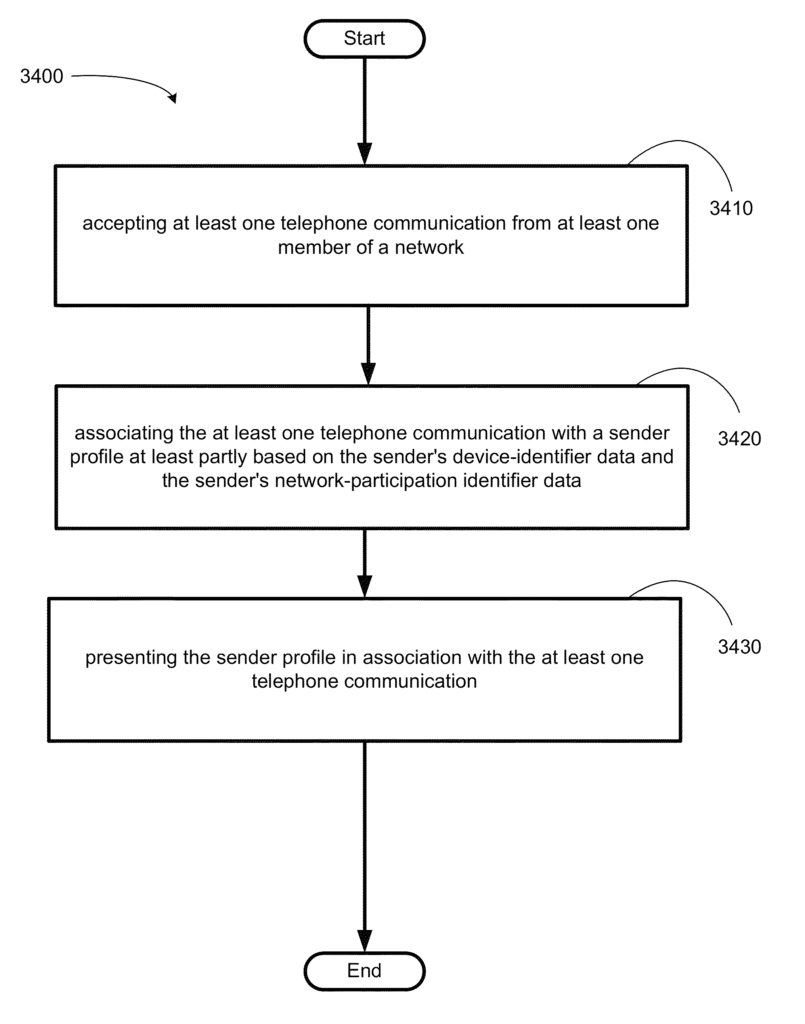
The Elwha LLC invention works as follows
Methods, apparatuses, computer program products, devices and systems are described that carry out accepting at least one social network message from at least one member of a network; disambiguating the at least one search term including associating the at least one search term with at least one of network-participation identifier data or device-identifier data; and presenting the sender profile in association with the at least one.
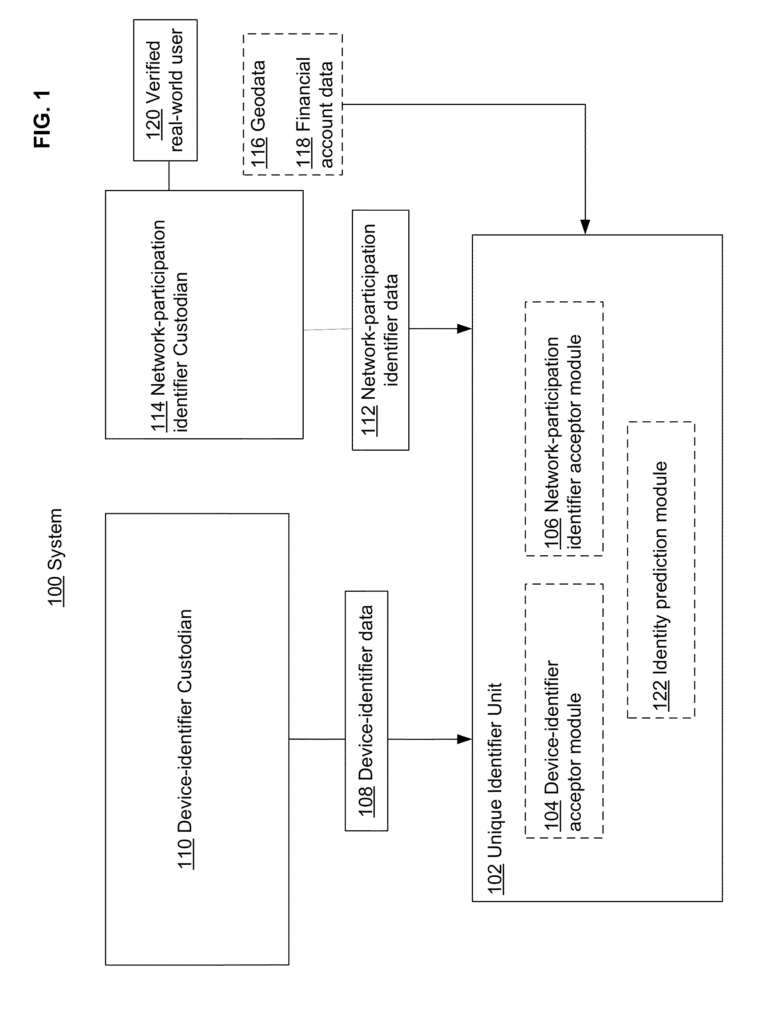
Background for Computational methods and systems for identifying communications partners
An embodiment” provides a system. In one implementation, the system includes but is not limited to circuitry for accepting at least one social network message from at least one member of a network; circuitry for associating the at least one social network message with a sender profile at least partly based on the sender’s device-identifier data and the sender’s network-participation identifier data; and circuitry for presenting the sender profile in association with the at least one social network message. Other system aspects, in addition to those described above, are described in the drawings, text, and claims that form a part the present disclosure.
The circuitry or programming may be a combination of software, hardware, and firmware, depending on the design decisions of the system designer.
The system designer can choose to design the system in a way that includes a combination of hardware, firmware, and software to achieve the method aspects described herein.
An embodiment” provides a computer implemented method. In one implementation, the method includes but is not limited to accepting at least one social network message from at least one member of a network; associating the at least one social network message with a sender profile at least partly based on the sender’s device-identifier data and the sender’s network-participation identifier data; and presenting the sender profile in association with the at least one social network message. Other method aspects, in addition to those described above, are described in the drawings, text, and claims that form a part the present disclosure.
An embodiment” is an article of manufacture that includes a computer-programme product. In one implementation, the article of manufacture includes but is not limited to a signal-bearing medium configured by one or more instructions related to (a) accepting at least one social network message from at least one member of a network; (b) associating the at least one social network message with a sender profile at least partly based on the sender’s device-identifier data and the sender’s network-participation identifier data; and (c) presenting the sender profile in association with the at least one social network message. Other computer program product features are described, in addition to those mentioned above, in the claims and drawings that form a part the disclosure.
An embodiment is a system.” The system may include, but not be limited to, a computing device or instructions in one implementation. The instructions when executed on the computing device cause the computing device to (a) accept at least one social network message from at least one member of a network; (b) associate the at least one social network message with a sender profile at least partly based on the sender’s device-identifier data and the sender’s network-participation identifier data; and (c) present the sender profile in association with the at least one social network message. Other system aspects, in addition to those described above, are described in the drawings, text, and claims that form a part the present disclosure.
The present disclosure includes text, drawings, and/or claims (e.g. detailed description and/or claims).
The summary may include generalizations, omissions or inclusions of details. Those skilled in the field will understand that this summary is only intended as an example and NOT to be limiting in any way. The teachings will reveal other aspects, features and advantages of devices, processes, or any other subject matter.
In the detailed description that follows, the drawings are referred to. They form part of this document. In the drawings, symbols that are similar to one another usually identify similar components unless context dictates something else. The detailed description, drawings and claims do not limit the illustrative examples. Other embodiments can be used, and changes made without departing the spirit or scope presented here.
FIG. FIG. 1 shows an example of a system 100 that can be used to implement embodiments. The system 100 comprises a unique identification unit 102. The unique identifier unit 102 may contain, for example, device-identifier acceptor module 104 and network-participation identifier acceptor module 106. The unique identifier unit may communicate directly or over a network with the device-identifier custodian to accept data 108. Unique identifier unit 102 may also communicate over a network or directly with network-participation identifier custodian 114 to accept network-participation identifier data 112 associated with a verified real-world user 120 associated with the at least one communication device. Unique identifier unit may accept financial account data or geodata. Unique identifier unit 102 may also include identity prediction module 122 for associating network-participation identifier data with a verified real-world user 120 associated with a communication device.
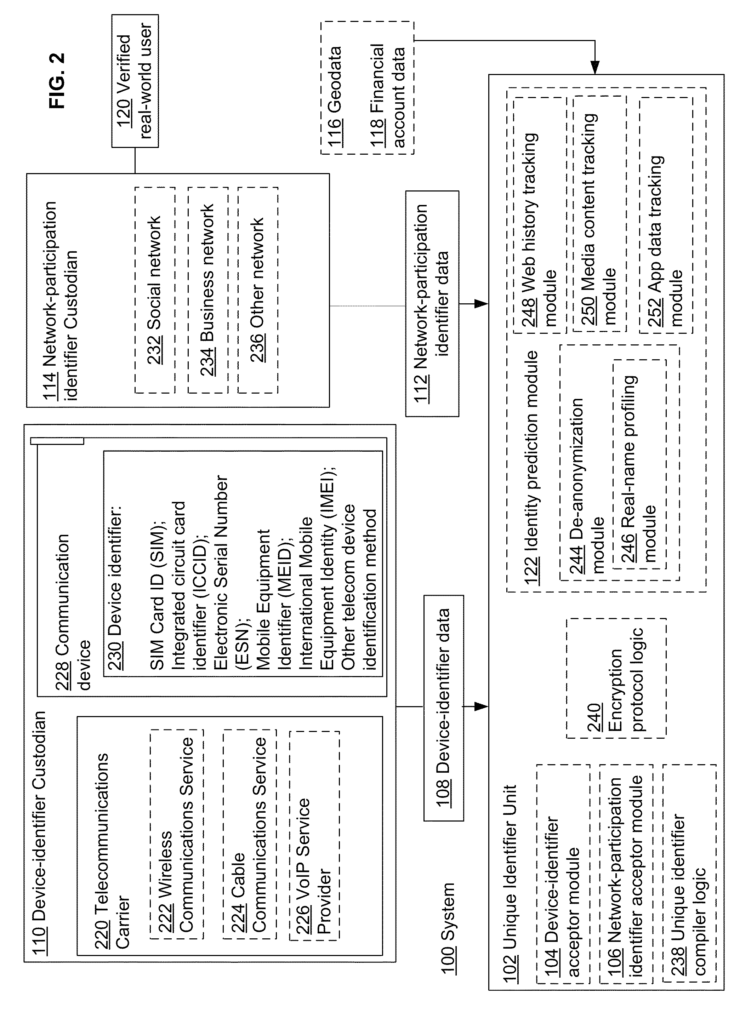
In FIG. 1, unique identifier unit 102 may assign a unique identifier based on accepted device-identifier data 108 and accepted network-participation identifier data 112. Unique identifier unit may also assign geodata (116) and/or financial account information (118) to an assigned unique ID.
In FIG. The unique identifier 102 may be included in a system 100. “Of course, any computing device can be used to implement the unique identifier unit for special purposes, including, for example a workstation or desktop computer, networked computers, servers, databases, virtual machines running within computing devices, mobile computing devices, tablet PCs, etc.
Also, not all the unique identifier units 102 must be implemented on one computing device. The unique identifier 102, for example, may be implemented or operable on remote computers, while the user interface and/or a local instance of unique identifier 102 is implemented and/or occurs on local computers. Aspects of the unique identification unit 102 can be implemented differently than shown in FIG. 1. The unique identifier unit can include, for example, the functionality of an interface. The unique identifier 120 can perform simple data relay and/or complex analysis of data, such as fuzzy logic or traditional logic. Many methods for assigning unique identifications are described in this document or in the literature. These include, for instance, algorithms that generate globally unique identifiers and universally unique IDs. Other random number generation methods may also be used. In some embodiments, the unique identifier unit 102 may assign unique identifiers based on device-identifier data 108 and/or network-participation identifier data 112 available as updates through a network.
The “Unique identifier 102” may be able to access data in virtually any memory capable of storing and/or providing access to information, such as in a many-to one, many-to many, or many-to many relationship. This memory can include, for instance, a relational or object-oriented database. Examples are given in greater detail below.
FIG. “FIG. 1. In FIG. In FIG. The unique identifier unit may communicate directly or over a network with the device-identifier provider 110 to accept data 108 about device-identifiers, such as device identifiers 230. Unique identifier unit 102 may also communicate over a network or directly with network-participation identifier custodian 114 to accept network-participation identifier data 112 associated with a verified real-world user 120 associated with the at least one communication device, perhaps from social network 232, business network 234, and/or other network 236.
The unique identifier unit can generate a list of unique identifications which is compiled or encrypted and may be linked with geodata, financial account data and/or other information.
In some embodiments, the unique identifier compiling logic 112 can create a set of composite identifiers which are used, for instance, to disambiguate results when searching in a network, based on data such as device identifiers, network participation data and/or geographic data. Unique identifier unit 10 can be operated either by a telecom or a social network or owner or both, in collaboration. The list of unique identifiers discussed here can be used to represent all or substantially the unique devices within a social network or another communications network.
A directory of uniquely identified devices can be used to facilitate financial transactions for members of a social network that is associated with the device.
In some embodiments, unique identifier unit 102 may also include identity prediction module 122 for associating network-participation identifier data with a verified real-world user 120 associated with a communication device 228. Identity prediction module 122 may include various search and/or matching functions for associating network-participation identifier data 112 with a verified real-world user 120 associated with a communications device 228. Identity prediction module 122, for example, may include deanonymization module 244, and real-name profile module 246. The identity prediction module 122 can also include media content tracking modules 250 and/or 252, as well as web history tracking module 248.
For the purposes of this Application, SIM is used to include mini-SIM and micro-SIM. It also includes Universal Subscriber Identity module, CDMA Subscriber Identity module, Universal Integrated Circuit Card (UICC), Removable User Identity Modul, virtual SIM and other variants.
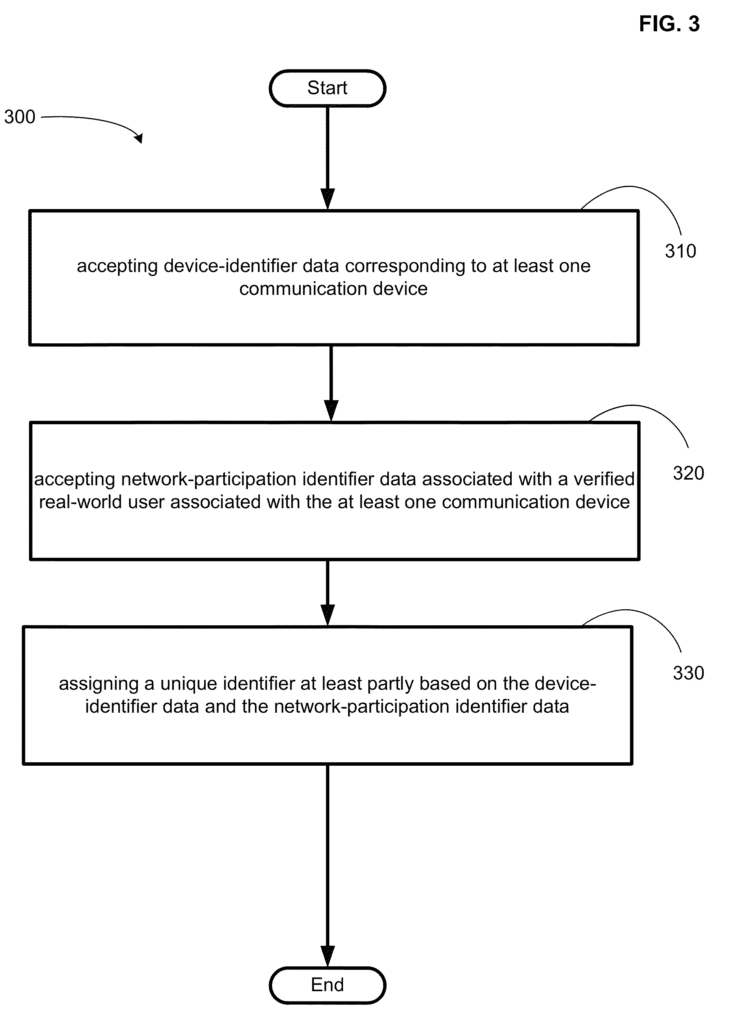
As referenced herein, the unique identifier unit 102 may be used to perform various data querying and/or recall techniques with respect to the device-identifier data 108 and/or network-participation identifier data 112, in order to assign a unique identifier. For example, where the network-participation identifier data 112 is organized, keyed to, and/or otherwise accessible using one or more user accounts such as social network, email, or the like, unique identifier unit 102 may employ various Boolean, statistical, and/or semi-boolean searching techniques to assign a unique identifier. Unique identifier unit may also perform various Boolean and statistical techniques to assign a unique ID when device-identifier information 108, for instance, is organized, keyed, or otherwise accessible by one or more custodians 110.
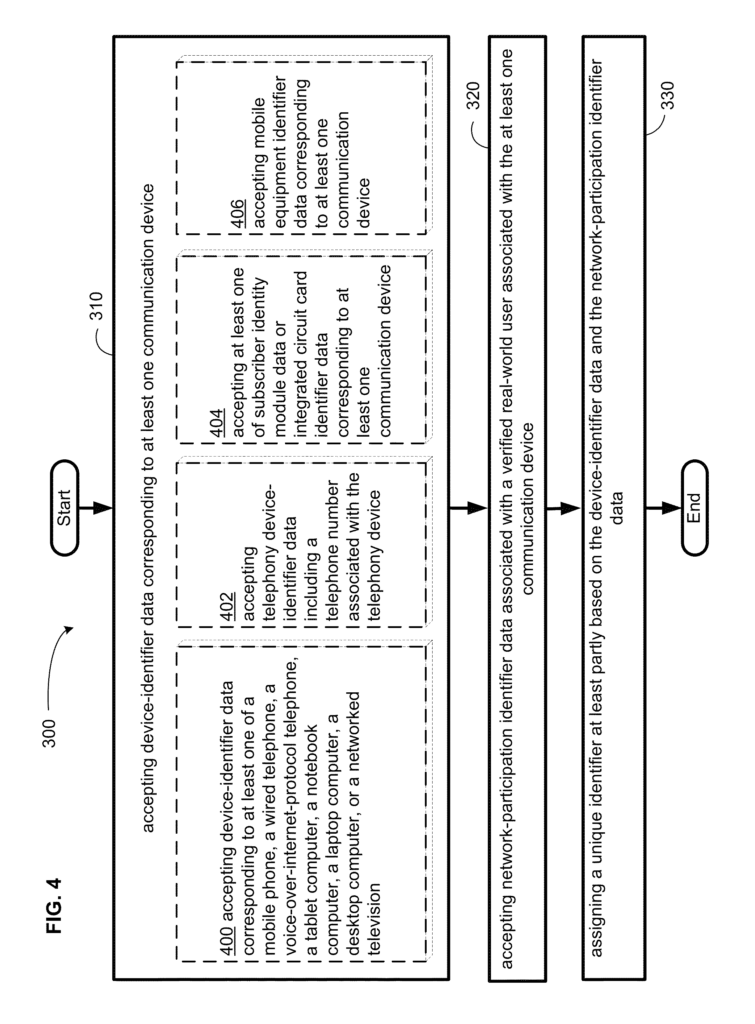
Click here to view the patent on Google Patents.
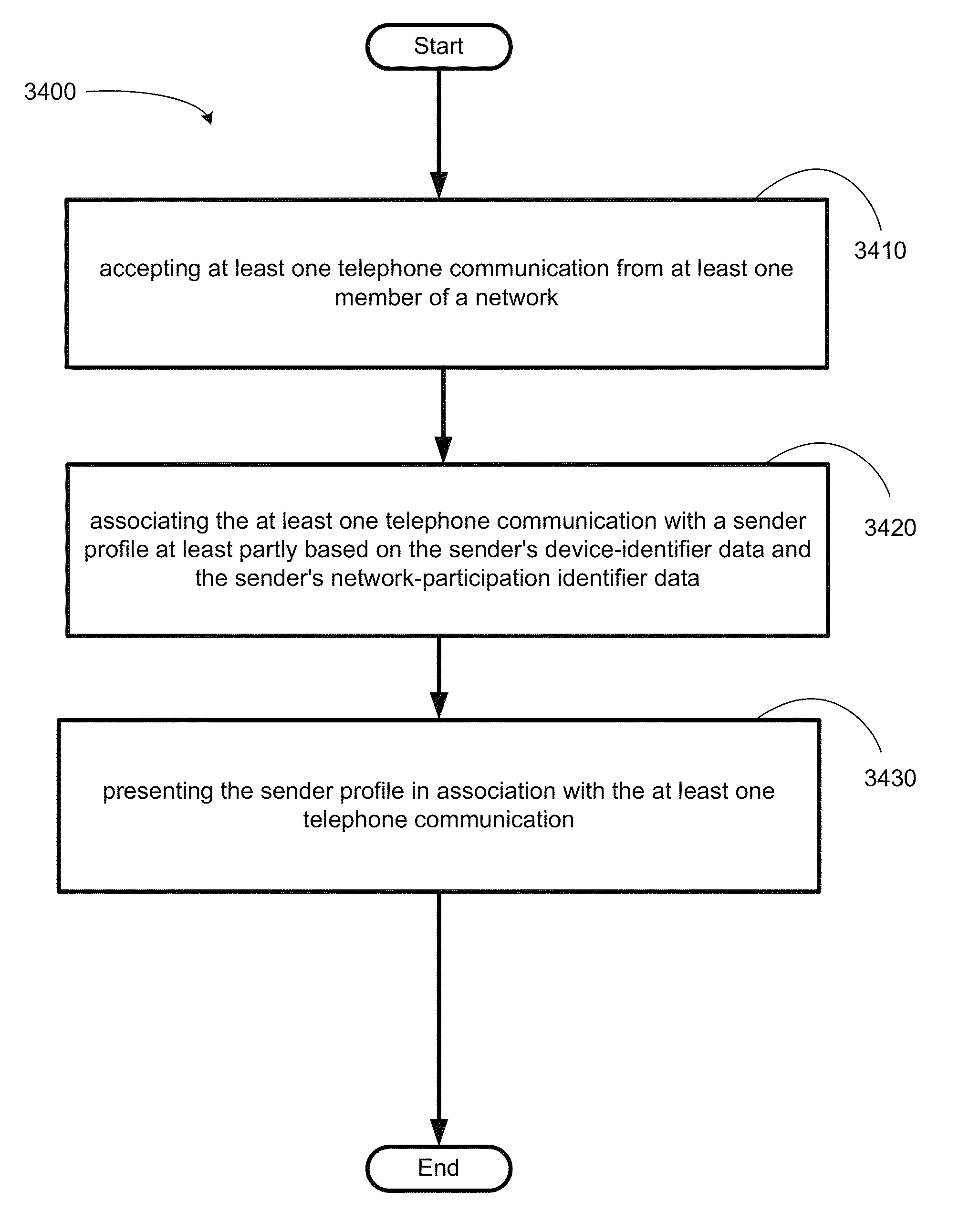
Leave a Reply